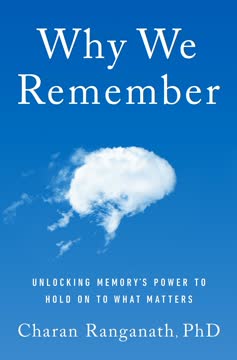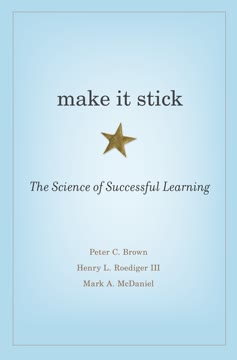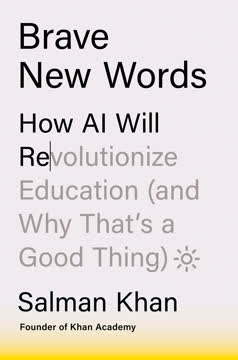Key Takeaways
1. The Brain's Two Learning Pathways: Declarative and Procedural
"Learning involves connecting, strengthening, and extending sets of neural links in long-term memory in the neocortex. We refer to this process as learn it, link it."
Declarative learning is conscious and involves working memory and the hippocampus. It's fast to learn but slower to use. This pathway is great for learning facts, events, and explicit knowledge.
Procedural learning is largely nonconscious and involves the basal ganglia. It's slower to learn but faster to use once mastered. This pathway is ideal for learning skills, habits, and implicit knowledge.
Both pathways are crucial for effective learning:
- Declarative: Good for initial understanding and flexible application
- Procedural: Enables automaticity and quick recall
- Best learning occurs when both pathways are engaged
2. Working Memory: The Brain's Juggling Act
"An average working memory can hold up to four 'balls' of information before ideas begin slipping from the mind."
Working memory capacity varies among individuals and affects learning ability. It's like a mental juggling act, where some students can juggle more "balls" of information than others.
Key points about working memory:
- Limited capacity: Most people can hold 3-4 items at once
- Affects learning speed: Larger capacity often means faster learning
- Not fixed: Can be enhanced through strategies and practice
Teachers can support students with varied working memory capacities by:
- Chunking information into manageable pieces
- Providing visual aids and graphic organizers
- Using retrieval practice to move information to long-term memory
- Offering scaffolded instruction for complex tasks
3. Active Learning: Engaging the Brain for Better Retention
"Active learning engages students in the process of learning through activities and/or discussion in class, as opposed to passively listening to an expert."
Engage multiple senses to enhance learning. Active learning strategies involve students in the learning process, leading to better retention and understanding.
Effective active learning strategies include:
- Think-pair-share discussions
- Hands-on experiments and demonstrations
- Problem-solving exercises
- Student-led presentations
- Collaborative group projects
Benefits of active learning:
- Increases student engagement and motivation
- Promotes deeper understanding of concepts
- Develops critical thinking and problem-solving skills
- Enhances retention of information
- Fosters peer learning and communication skills
4. The Power of Retrieval Practice in Solidifying Knowledge
"Retrieval practice is one of the best techniques for strengthening new information in long-term memory."
Test yourself frequently. Retrieval practice involves actively recalling information from memory, which strengthens neural connections and improves long-term retention.
Effective retrieval practice methods:
- Flashcards
- Practice quizzes
- Summarizing without looking at notes
- Teaching concepts to others
- Applying knowledge to new situations
Benefits of retrieval practice:
- Identifies knowledge gaps
- Strengthens memory recall
- Improves transfer of knowledge to new contexts
- Reduces test anxiety by building confidence
- More effective than passive re-reading or highlighting
5. Interleaving and Spaced Repetition: Strategies for Long-Term Retention
"Interleaving helps students learn virtually any subject, including sports, math, music, art, and language."
Mix it up and space it out. Interleaving involves mixing different topics or types of problems within a study session, while spaced repetition spreads review sessions over time.
Implementing interleaving and spaced repetition:
- Alternate between related topics (e.g., different math concepts)
- Revisit material at increasing intervals (e.g., 1 day, 1 week, 1 month)
- Use varied practice formats (e.g., multiple-choice, short answer, application)
- Incorporate review of previous material in new lessons
Benefits:
- Enhances discrimination between similar concepts
- Improves long-term retention and recall
- Develops flexible thinking and problem-solving skills
- Mimics real-world application of knowledge
6. Stress and Learning: Finding the Sweet Spot
"Moderate transient stress, on the other hand, releases glucocorticoids and other chemicals that improve the ability to learn and can improve cognition, working memory, and physical strength."
Optimal stress enhances learning. While chronic stress hinders learning, moderate, short-term stress can actually improve cognitive function and memory formation.
The stress-learning relationship:
- Too little stress: Boredom and lack of engagement
- Optimal stress: Enhanced focus and memory formation
- Too much stress: Impaired cognitive function and retention
Strategies for managing stress in the classroom:
- Create a supportive, yet challenging learning environment
- Use timed activities to create mild, productive pressure
- Teach stress-management techniques (e.g., deep breathing, mindfulness)
- Provide clear expectations and scaffolding for difficult tasks
- Celebrate small victories to build confidence
7. Building Effective Classroom Procedures and Habits
"Procedures need to be taught from the first day, then reinforced and retaught as necessary. Consistency is paramount."
Establish routines early. Well-designed classroom procedures create a structured environment that supports learning and reduces cognitive load for students.
Key areas for establishing procedures:
- Entering and exiting the classroom
- Transitioning between activities
- Distributing and collecting materials
- Asking for help or using the restroom
- Participating in discussions
Steps for implementing effective procedures:
- Explicitly teach and model the procedure
- Practice the procedure with students
- Reinforce and praise correct implementation
- Consistently enforce procedures
- Periodically review and adjust as needed
8. Collaborative Learning: Harnessing the Power of Peer Interaction
"Collaborative learning groups are those with a common goal, an equal distribution of workload, and close contact within the group while they work toward the goal."
Learn together, achieve more. Collaborative learning leverages social interaction to enhance understanding, develop communication skills, and build a sense of community in the classroom.
Effective collaborative learning strategies:
- Jigsaw method: Students become experts on a subtopic and teach others
- Think-pair-share: Individual reflection followed by partner discussion
- Group projects with defined roles
- Peer teaching and tutoring
- Collaborative problem-solving sessions
Benefits of collaborative learning:
- Promotes active engagement with material
- Develops critical thinking and communication skills
- Exposes students to diverse perspectives
- Builds social and emotional skills
- Prepares students for real-world teamwork
9. Online Teaching: Leveraging Technology for Effective Learning
"Well-done active learning includes retrieval practice. It makes students think and forces them to check whether they've begun to make links in long-term memory, in the neocortex."
Engage virtually, learn actively. Effective online teaching combines synchronous and asynchronous elements to create an engaging, interactive learning experience.
Key strategies for successful online teaching:
- Use multimedia: Combine visual and auditory elements
- Chunk content: Break lessons into short, focused segments
- Incorporate interactive elements: Quizzes, discussions, collaborative tasks
- Provide clear structure and expectations
- Maintain a strong teacher presence through regular communication
Balancing synchronous and asynchronous learning:
- Synchronous: Live sessions for discussions, Q&A, and collaborative work
- Asynchronous: Pre-recorded lectures, readings, and self-paced activities
- Blend both approaches to cater to different learning styles and schedules
10. Lesson Planning: Charting the Course for Student Success
"Master teachers are among the best planners. They start by plotting a map—that is, a lesson plan."
Plan with purpose. Effective lesson planning ensures clear learning objectives, engaging activities, and meaningful assessment to guide student learning.
Essential elements of a strong lesson plan:
- Clear, measurable learning objectives
- Activation of prior knowledge
- Direct instruction and modeling
- Guided practice and active learning activities
- Independent practice
- Formative assessment and feedback
- Closure and reflection
Best practices for lesson planning:
- Align activities with learning objectives
- Incorporate a variety of teaching strategies
- Plan for differentiation to meet diverse student needs
- Include opportunities for retrieval practice and interleaving
- Build in time for student questions and discussion
- Prepare backup activities or extensions for flexibility
Last updated:
FAQ
What's Uncommon Sense Teaching about?
- Neuroscience in Education: The book explores how brain science can enhance teaching practices, offering practical strategies for educators.
- Bridging Theory and Practice: It aims to connect educational theory with classroom practice, providing actionable advice for teachers.
- Target Audience: While primarily for educators, it also benefits parents and caregivers involved in supporting student learning.
Why should I read Uncommon Sense Teaching?
- Research-Based Strategies: The book is grounded in scientific research, translating complex neuroscience concepts into practical classroom applications.
- Improving Student Outcomes: Understanding brain function helps teachers implement strategies that enhance student engagement and retention.
- Accessible and Engaging: The material is presented in an engaging manner, making complex ideas easy to grasp and apply.
What are the key takeaways of Uncommon Sense Teaching?
- Memory and Learning: Emphasizes the difference between working memory and long-term memory, crucial for effective learning.
- Active Learning Importance: Highlights active learning techniques like retrieval practice to solidify knowledge in long-term memory.
- Inclusivity in Teaching: Discusses recognizing diverse learning styles and differentiating instruction to meet all learners' needs.
What is the learn it, link it process in Uncommon Sense Teaching?
- Definition of the Process: Involves forming connections between neurons when learning new information, reinforcing and extending those connections.
- Hebbian Learning Principle: Based on the principle that "neurons that fire together wire together," strengthening neural connections through practice.
- Application in Teaching: Teachers can facilitate this by incorporating varied practice and retrieval exercises into lessons.
How does Uncommon Sense Teaching address procrastination?
- Understanding Procrastination: Identifies procrastination as a challenge stemming from anxiety or ineffective study strategies.
- Pomodoro Technique: Recommends this technique, involving focused work bursts followed by short breaks, to maintain concentration.
- Encouraging Accountability: Suggests structured assignments with clear deadlines to help students manage tasks effectively.
What are the differences between declarative and procedural learning in Uncommon Sense Teaching?
- Declarative Learning: Involves conscious awareness, facilitated by working memory and the hippocampus, including facts and concepts.
- Procedural Learning: Largely nonconscious, involving the basal ganglia, encompassing skills and habits that become automatic through practice.
- Importance of Both Systems: Effective teaching should engage both systems for deeper understanding and flexible knowledge application.
What strategies does Uncommon Sense Teaching recommend for active learning?
- Retrieval Practice: Emphasizes recalling information from memory to strengthen long-term memory links.
- Interleaving Practice: Advocates for mixing different topics during practice to enhance understanding and pattern recognition.
- Collaborative Learning: Recommends engaging students in activities like think-pair-share to promote active learning and peer interaction.
What role does working memory play in learning according to Uncommon Sense Teaching?
- Limited Capacity: Working memory can hold only a few pieces of information, leading to learning difficulties if relied upon solely.
- Connection to Long-Term Memory: Effective learning requires transferring information from working memory to long-term memory.
- Strategies to Enhance: Suggests breaking down instructions and using visual aids to support students with lower working memory capacity.
How does Uncommon Sense Teaching address student resistance?
- Understanding Resistance Triggers: Identifies factors like personal issues and past experiences that contribute to resistance.
- Building Trust and Rapport: Suggests providing specific praise and reassurance to establish trust and openness to learning.
- One-on-One Meetings: Advocates for individual meetings to empathize with students and create action plans for behavioral issues.
What is the role of stress in learning according to Uncommon Sense Teaching?
- Types of Stress: Differentiates between chronic stress, which is harmful, and transient stress, which can enhance performance.
- Stress and Memory: Discusses how stress hormones affect memory consolidation and retrieval, emphasizing balance.
- Utilizing Eustress: Encourages harnessing moderate stress to improve focus and efficiency in learning tasks.
How does Uncommon Sense Teaching suggest building a positive classroom culture?
- Establishing Clear Expectations: Stresses teaching procedures from the start, with consistency being paramount.
- Creating a Safe Environment: Emphasizes a safe, orderly classroom to reduce anxiety and foster engagement.
- Encouraging Collaboration: Advocates for collaborative learning to build community and support among students.
What are the best quotes from Uncommon Sense Teaching and what do they mean?
- “Learning is about making changes in the brain.”: Highlights the importance of understanding brain function to improve teaching.
- “Retrieval practice is one of the best ways to strengthen neural links in long-term memory.”: Emphasizes the effectiveness of active recall in enhancing memory retention.
- “Teaching is a learning profession—whatever you know, it helps to learn more.”: Encourages ongoing professional development for educators to improve classroom effectiveness.
Review Summary
Uncommon Sense Teaching receives high praise for its practical, neuroscience-based approach to education. Readers appreciate the book's insights on memory, learning pathways, and effective teaching strategies. Many find it valuable for both teachers and learners, highlighting concepts like retrieval practice, interleaving, and the "learn it, link it" process. While some experienced educators find parts familiar, most agree it offers fresh perspectives and actionable advice. The book is particularly commended for its clear explanations of complex brain processes and their applications in the classroom.
Similar Books










Download PDF
Download EPUB
.epub digital book format is ideal for reading ebooks on phones, tablets, and e-readers.








